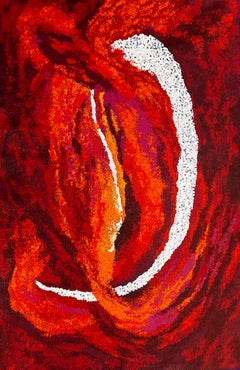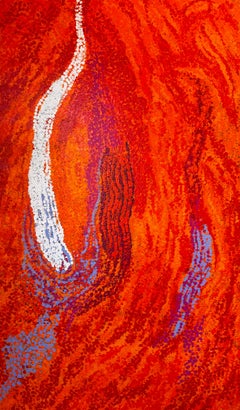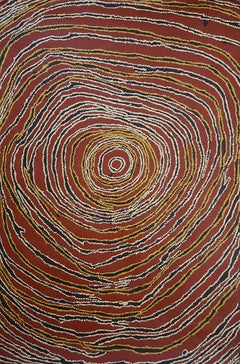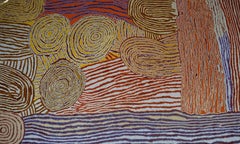Want more images or videos?
Request additional images or videos from the seller
1 of 10
Maureen BakerMy Grandmother's Country2024
2024
$5,000List Price
About the Item
- Creator:Maureen Baker (1962, Aboriginal Australian)
- Creation Year:2024
- Dimensions:Height: 35.44 in (90 cm)Width: 59.06 in (150 cm)
- Medium:
- Movement & Style:
- Period:
- Condition:
- Gallery Location:Miami, FL
- Reference Number:1stDibs: LU13614926912
About the Seller
5.0
Vetted Professional Seller
Every seller passes strict standards for authenticity and reliability
Established in 2011
1stDibs seller since 2012
75 sales on 1stDibs
Authenticity Guarantee
In the unlikely event there’s an issue with an item’s authenticity, contact us within 1 year for a full refund. DetailsMoney-Back Guarantee
If your item is not as described, is damaged in transit, or does not arrive, contact us within 7 days for a full refund. Details24-Hour Cancellation
You have a 24-hour grace period in which to reconsider your purchase, with no questions asked.Vetted Professional Sellers
Our world-class sellers must adhere to strict standards for service and quality, maintaining the integrity of our listings.Price-Match Guarantee
If you find that a seller listed the same item for a lower price elsewhere, we’ll match it.Trusted Global Delivery
Our best-in-class carrier network provides specialized shipping options worldwide, including custom delivery.You May Also Like
Little Landscape 07 - Modern Abstract Landscape, Nature Painting, Framed
By Grzegorz Wójcik
Located in Salzburg, AT
This painting is signed on the back
A few words of the artist about his art:
When i painting landscapes, I usually choose simple geometric arrangements, contrasts of verticals and levels. I juxtapose the smooth surface of the sky with the rough texture of earth or grass.
I paint symmetrical reflections in water and rhythmic repetitions of trees. Even an ordinary, seemingly uninteresting fragment of the suburban landscape hides a beauty that I want to see and then transfer to the canvas.
I am inspired by nature because it contains a hidden secret of existence. For me, painting it is a reflection on life and passing away. It is an attempt to capture the imperceptible essence, to paint what cannot be seen.
I think that my paintings can be a respite, an antidote for a man tired of technology, constant rush, hustle and bustle of the city.
Grzegorz Wójcik...
Category
2010s Contemporary Landscape Paintings
Materials
Cotton Canvas, Acrylic
$481
H 11.11 in W 11.11 in D 1.07 in
Little Landscape 08 - Modern Abstract Landscape, Nature Painting, Framed
By Grzegorz Wójcik
Located in Salzburg, AT
This painting is signed on the back
A few words of the artist about his art:
When i painting landscapes, I usually choose simple geometric arrangements, contrasts of verticals and ...
Category
2010s Contemporary Landscape Paintings
Materials
Cotton Canvas, Acrylic
$481
H 11.11 in W 11.11 in D 1.07 in
Little Landscape 01 - Modern Abstract Landscape, Nature Painting, Framed
By Grzegorz Wójcik
Located in Salzburg, AT
This painting is signed on the back
A few words of the artist about his art:
When i painting landscapes, I usually choose simple geometric arrangements, contrasts of verticals and ...
Category
2010s Contemporary Landscape Paintings
Materials
Cotton Canvas, Acrylic
$481
H 11.11 in W 11.11 in D 1.07 in
Little Landscape 04 - Modern Abstract Landscape, Nature Painting, Framed
By Grzegorz Wójcik
Located in Salzburg, AT
This painting is signed on the back
A few words of the artist about his art:
When i painting landscapes, I usually choose simple geometric arrangements, contrasts of verticals and levels. I juxtapose the smooth surface of the sky with the rough texture of earth or grass.
I paint symmetrical reflections in water and rhythmic repetitions of trees. Even an ordinary, seemingly uninteresting fragment of the suburban landscape hides a beauty that I want to see and then transfer to the canvas.
I am inspired by nature because it contains a hidden secret of existence. For me, painting it is a reflection on life and passing away. It is an attempt to capture the imperceptible essence, to paint what cannot be seen.
I think that my paintings can be a respite, an antidote for a man tired of technology, constant rush, hustle and bustle of the city.
Grzegorz Wójcik...
Category
2010s Contemporary Landscape Paintings
Materials
Cotton Canvas, Acrylic
$481
H 11.11 in W 11.11 in D 1.07 in
Little Landscape 02 - Modern Abstract Landscape, Nature Painting, Framed
By Grzegorz Wójcik
Located in Salzburg, AT
This painting is signed on the back
A few words of the artist about his art:
When i painting landscapes, I usually choose simple geometric arrangements, contrasts of verticals and ...
Category
2010s Contemporary Landscape Paintings
Materials
Cotton Canvas, Acrylic
$481
H 11.11 in W 11.11 in D 1.07 in
Untitled 16 - Contemporary Abstract and Colorful Painting, Textile Lightness
By Tomasz Prymon
Located in Salzburg, AT
About Prymon’s Exhibition Dopaminum and his paintings:
”Dopaminum” - Tomasz Prymon
Dopamine – colloquially referred to as the hormone of love and happiness. Why is this organic che...
Category
2010s Contemporary Abstract Paintings
Materials
Cotton Canvas, Acrylic
$2,527
H 43.31 in W 31.5 in D 0.79 in
Untitled 12 - Contemporary Abstract and Colorful Painting, Conceptual Art
By Tomasz Prymon
Located in Salzburg, AT
About Prymon’s Exhibition Dopaminum and his paintings:
”Dopaminum” - Tomasz Prymon
Dopamine – colloquially referred to as the hormone of love and happiness. Why is this organic che...
Category
2010s Contemporary Abstract Paintings
Materials
Cotton Canvas, Acrylic
$1,323
H 25.6 in W 19.69 in D 0.79 in
Propagation Study III
Located in Atlanta, GA
A rhythm exists here on the farm, beginning with the sunrise and the sounds of nature awakening. My art is a reaction to this sense of place. Whether I’m in the studio, tending to th...
Category
2010s Contemporary Abstract Paintings
Materials
Canvas, Dye, Emulsion, Cotton Canvas, Archival Ink, Mixed Media, Acrylic...
Intimate IV
Located in Atlanta, GA
A rhythm exists here on the farm, beginning with the sunrise and the sounds of nature awakening. My art is a reaction to this sense of place. Whether I’m in the studio, tending to th...
Category
2010s Contemporary Abstract Paintings
Materials
Canvas, Dye, Emulsion, Cotton Canvas, Archival Ink, Mixed Media, Acrylic...
Indigo Wild I
Located in Atlanta, GA
A rhythm exists here on the farm, beginning with the sunrise and the sounds of nature awakening. My art is a reaction to this sense of place. Whether I’m in the studio, tending to th...
Category
2010s Contemporary Abstract Paintings
Materials
Canvas, Dye, Emulsion, Cotton Canvas, Archival Ink, Mixed Media, Acrylic...
More From This Seller
View AllPikarli - My Country
By Yannima Tommy Watson
Located in Miami, FL
Yannima Tommy Watson is a Pitjantjatjara artist born around the 1930s, in the bush some 44km west of the small isolated community of Irrunytju. Not yet very well known to the French public, despite his participation in the architectural project of the Musée du Quai Branly, Tommy Watson is nevertheless often considered the greatest living Aboriginal artist.
Like many aborigines of his generation, he lived a traditional, nomadic or semi-nomadic life before his contact with Western civilization; then he will occupy the only jobs that the Aborigines find: herdsmen (until Yuendumu), laborers for the construction of infrastructures in the desert. Throughout this period he became familiar with his "country", a harsh region, and deepened his knowledge, both profane and sacred, relating to Dreams and Dreamtimes, to the connections between sacred sites and the Ancestors. He will even work in Papunya, where the artistic movement started. But the Pijantjarra are intransigent with tradition…no question at this time of revealing the motives and the secret stories.
The North of South Australia, the region where he is from, was touched by the pictorial movement only at the very beginning of the 2000s. In 2001, Tommy began his career as an artist in Irrunytju (Wingellina). He is a young artist… He learns by observing other painters and draws on the experiences of a long life and on the exceptional knowledge he has stored up. But quickly he will find his way, a radically new style where color plays a major role. Very quickly, the iconography now well known by the artists of Yuendumu, or the Western Desert, Balgo or Lajamanu disappeared. The symbols are no longer there. As Rover Thomas, Emily Kame or Paddy Bedford had done before him, this is a real artistic revolution. For Tommy, it is not a question of describing his Dream (Caterpillar), the routes taken by the Ancestors. He concentrates on a site, a story, sometimes very profane, the memory of a meeting, of a hunting party, tries to condense his memories, the information of which he is the depositary, to add a poetic touch to it, sometimes melancholy, and this gives a painting with a very abstract aspect. It is a painting where the emotion is very present, undoubtedly less cerebral than the art of the neighbors of the north the Pintupi, like Ronnie Tjampitjinpa, George...
Category
2010s Contemporary Abstract Paintings
Materials
Cotton Canvas, Acrylic, Linen
Ngayuku Kgura (My Country)
By Yannima Tommy Watson
Located in Miami, FL
Yannima Tommy Watson is a Pitjantjatjara artist born around the 1930s, in the bush some 44km west of the small isolated community of Irrunytju. Not yet very well known to the French public, despite his participation in the architectural project of the Musée du Quai Branly, Tommy Watson is nevertheless often considered the greatest living Aboriginal artist.
Like many aborigines of his generation, he lived a traditional, nomadic or semi-nomadic life before his contact with Western civilization; then he will occupy the only jobs that the Aborigines find: herdsmen (until Yuendumu), laborers for the construction of infrastructures in the desert. Throughout this period he became familiar with his "country", a harsh region, and deepened his knowledge, both profane and sacred, relating to Dreams and Dreamtimes, to the connections between sacred sites and the Ancestors. He will even work in Papunya, where the artistic movement started. But the Pijantjarra are intransigent with tradition…no question at this time of revealing the motives and the secret stories.
The North of South Australia, the region where he is from, was touched by the pictorial movement only at the very beginning of the 2000s. In 2001, Tommy began his career as an artist in Irrunytju (Wingellina). He is a young artist… He learns by observing other painters and draws on the experiences of a long life and on the exceptional knowledge he has stored up. But quickly he will find his way, a radically new style where color plays a major role. Very quickly, the iconography now well known by the artists of Yuendumu, or the Western Desert, Balgo or Lajamanu disappeared. The symbols are no longer there. As Rover Thomas, Emily Kame or Paddy Bedford had done before him, this is a real artistic revolution. For Tommy, it is not a question of describing his Dream (Caterpillar), the routes taken by the Ancestors. He concentrates on a site, a story, sometimes very profane, the memory of a meeting, of a hunting party, tries to condense his memories, the information of which he is the depositary, to add a poetic touch to it, sometimes melancholy, and this gives a painting with a very abstract aspect. It is a painting where the emotion is very present, undoubtedly less cerebral than the art of the neighbors of the north the Pintupi, like Ronnie Tjampitjinpa, George...
Category
2010s Contemporary Abstract Paintings
Materials
Linen, Cotton Canvas, Acrylic
Woman's Dreaming
By Walangkura Napanangka
Located in Miami, FL
As one of the last generation to remember a childhood lived in the desert hunting and gathering with her family, Walangkura Napanangka's paintings recall the stories of country and the location of specific sites in her traditional homeland west of the salt lake of Karrkurutinjinya (Lake Macdonald).
Born around 1946, at Tjitururrnga west of Kintore, in the remote and arid country between the Northern Territory and Western Australia, she lived with her father Rantji Tjapangati and mother Inyuwa Nampitjinpa and later, while still a teenager, travelled by foot with her family over the hundreds of kilometres from their remote desert home eventually joining Uta Uta Tjangala's group as they walked in to the settlements of Haasts Bluff and then Papunya.
The lure of settlement life with its promise of plentiful food and water belied the harsh conversion they would make to an alien lifestyle with its many problems and unfamiliar demands. The upheaval however, was ameliorated to some degree by the proximity of her immediate family including her mother Inyuwa, adoptive father Tutuma Tjapangati, and sister Pirrmangka Napanangka (now deceased) all of whom became artists.
Relocated to the community of Kintore in 1981 when the outstation movement began, Walangkura participated in the historic women's collaborative painting project (1994) that was initiated by the older women as a means of re-affirming their own spiritual and ancestral roots. It was a time of specifically female singing, ceremony and painting, away from the gaze of outsiders and men folk. The huge and colourful canvases that emerged from the women's camp were 'alive with the ritual excitement and narrative intensity of the occasion' (Johnson 2000: 197).
Within a year, Papunya Tula Artists, now established at Kintore, had taken on many of these women as full-time artists, revitalising the company after the deaths of many of the original 'painting men'. While individual women forged their own stylistic trajectory, these paintings were immediately distinguishable from the men's more cerebral and symmetrical style. They radiated an exuberant and vibrant energy, the felt heart-beat of women's affinity to country and spirit.
Walangkura's early works, created from 1996 onward, are characterized by masses of small markings and motifs covering large areas of canvas. Her favorite colour, a deep sandy orange predominates, accentuated against more somber blacks and reds and dusky greens or yellows. More recent works show a gestural quality though still tightly packed with an intensity of geometric line work representing sandhills. In a sense this provides a strong visual and contextual link to the men's linear style as exemplified by the works of George Tjungurrayi...
Category
2010s Contemporary Abstract Paintings
Materials
Linen, Cotton Canvas, Acrylic
Tjintjintjin
By Walangkura Napanangka
Located in Miami, FL
As one of the last generation to remember a childhood lived in the desert hunting and gathering with her family, Walangkura Napanangka's paintings recall the stories of country and the location of specific sites in her traditional homeland west of the salt lake of Karrkurutinjinya (Lake Macdonald).
Born around 1946, at Tjitururrnga west of Kintore, in the remote and arid country between the Northern Territory and Western Australia, she lived with her father Rantji Tjapangati and mother Inyuwa Nampitjinpa and later, while still a teenager, travelled by foot with her family over the hundreds of kilometres from their remote desert home eventually joining Uta Uta Tjangala's group as they walked in to the settlements of Haasts Bluff and then Papunya.
The lure of settlement life with its promise of plentiful food and water belied the harsh conversion they would make to an alien lifestyle with its many problems and unfamiliar demands. The upheaval however, was ameliorated to some degree by the proximity of her immediate family including her mother Inyuwa, adoptive father Tutuma Tjapangati, and sister Pirrmangka Napanangka (now deceased) all of whom became artists.
Relocated to the community of Kintore in 1981 when the outstation movement began, Walangkura participated in the historic women's collaborative painting project (1994) that was initiated by the older women as a means of re-affirming their own spiritual and ancestral roots. It was a time of specifically female singing, ceremony and painting, away from the gaze of outsiders and men folk. The huge and colourful canvases that emerged from the women's camp were 'alive with the ritual excitement and narrative intensity of the occasion' (Johnson 2000: 197).
Within a year, Papunya Tula Artists, now established at Kintore, had taken on many of these women as full-time artists, revitalising the company after the deaths of many of the original 'painting men'. While individual women forged their own stylistic trajectory, these paintings were immediately distinguishable from the men's more cerebral and symmetrical style. They radiated an exuberant and vibrant energy, the felt heart-beat of women's affinity to country and spirit.
Walangkura's early works, created from 1996 onward, are characterized by masses of small markings and motifs covering large areas of canvas. Her favorite colour, a deep sandy orange predominates, accentuated against more somber blacks and reds and dusky greens or yellows. More recent works show a gestural quality though still tightly packed with an intensity of geometric line work representing sandhills. In a sense this provides a strong visual and contextual link to the men's linear style as exemplified by the works of George Tjungurrayi...
Category
2010s Contemporary Abstract Paintings
Materials
Linen, Cotton Canvas, Acrylic
Medicine leaves
By Gloria Petyarre
Located in Miami, FL
Gloria Petyarre, sometimes referred to as Gloria Pitjara, was one of Australia's most successful and significant female artists. Her depiction of the K...
Category
2010s Abstract Abstract Paintings
Materials
Cotton Canvas, Acrylic
Tingari
By Warlimpirrnga Tjapaltjarri
Located in Miami, FL
Warlimpirrnga Tjapaltjarri was the son of Papalya Nangala and Waku Tjungurrayi, an old man who had three wives (Papalya and two of her siste...
Category
2010s Abstract Abstract Paintings
Materials
Cotton Canvas, Acrylic
Recently Viewed
View AllMore Ways To Browse
Carstens Galleries
Castellani Enrico
Contemplative Abstract Painting
Cowie Art
Famous Abstract Art
Giorgio Cavallon
Harriet Oil Painting
Hollins Bayard
Jack Whitten
Jeremie Rebourgeard
John R Campbell Oil Painting
Kosh Kosh
Linda Hill
Luxury Oil Paintings
Maria Paola Coda
Mark Ross
Marta Pokojowczyk
Monochromatic Yellow



